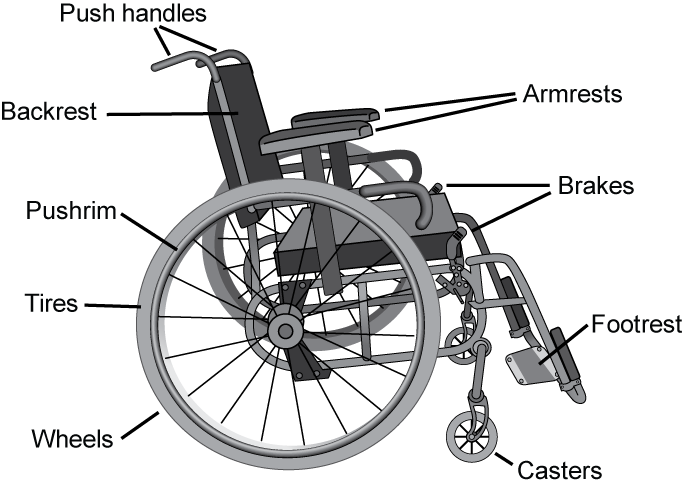
Wheelchair Selection Guide
Choosing the right wheelchair can be daunting. With so many variations and models on the market, it can be hard to decide what is best for your needs. When buying online, it can be difficult for people to make a decision because they cannot physically try the different models. Because of this concern, Breeze Mobility is dedicated to making sure you have all the information to make an educated decision for your health and happiness. In this wheelchair selection guide we will go over how to examine the different features of a wheelchair to help you find the perfect model.
Physical Capabilities
Understanding your physical capabilities is the first step in choosing a wheelchair. Based on your stamina and strength, there are three models of wheelchairs to decide between: manual wheelchair, companion wheelchair, and power wheelchair.
Manual wheelchairs refer to the self-propelled wheelchair which operators use their upper body strength to control the direction and speed of movement. This variation require upper body strength to operate and a generous amount of stamina depending on the duration of your use. If you do not possess a great amount of upper body strength, a companion or power chair may be a better choice.
Companion chairs are similar to manual chairs however, movement is controlled by a caregiver. These chairs do not allow the person sitting in the chair to propel themselves. This option is great if you have a dedicated caretaker assisting you. Companion chairs allow users to move without strain to their body. If controlling movement yourself is important to you, a manual or power chair is a better option.
Power chairs are the best option if you have limited stamina and upper body strength while still wanting to control your own movement. These chairs are battery-powered, motorized chairs with a control system for speed and direction. Power chairs are the best option if you are planning on long term or long-distance riding, but are generally more expensive than the previous options. However, a power chair can be worth the investment if you are looking for a long term mobility aid.
Structure of chair
Once you have determined between the three types of chairs, it is important to understand the structural difference between wheelchairs. Having knowledge of the different components of a chair allow you to adjust the structure according to your body type.
If your wheelchair for be for your personal use only, a fixed-frame chair is the best structure for you. Fixed-frame chairs are the most economical choice when you do not need versatility in the sizing of your wheelchair. If you are looking for a wheelchair that can be adjusted to accommodate several different users, a dual-height chair is your best option.
A very important part of finding a wheelchair that will cater to your specific needs is knowing the dimensions you require. There are four different measurements to know: seat depth, seat width, back height, and seat height.
- Seat Width: Choosing the correct wheelchair seat width is important because it can have short and long term effects on the user if not fitted properly. If your chair is too narrow, you can risk dangerous skin shearing. However, if your chair is too wide, the user’s’ legs rotate inward and can cause strain on the hips overtime. To make sure you have the right fit, measure the widest point of your hips or thighs. Then, add an extra inch to this number to account for the wheelchair seat upholstery. If you are going to add cushions to your chair, be sure to add the width of the cushions as well .
- Seat Depth: Much like the seat width, choosing an incorrect seat depth can have effects on the user’s health. If a seat is not deep enough, it can cause the user to shift his or her weight forward and produce an unstable environment. On the other hand, a seat that is too deep can result in the user to hunch forward to compensate and compromise good circulation. To avoid these risks, measure, while seated, from the back of your buttocks to the inner surface of the back of your knee. Once you have this measurement, subtract 2.5” to accommodate for the depth of the wheelchair seat upholstery.
- Back Height: If the back height of your chair is too low it can result in poor trunk stability. Contrarily, too high of a back height can restrict shoulder movements and cause residents to lean forward. To ensure that you get the proper fit, measure the distance between your buttocks to the underside of your extended arm. Once you have this number, subtract 4” if you have good trunk muscles and 3” if you have poor trunk muscles.
- Seat Height: The seat height is primarily determined by the user’s height. It is important to buy a wheelchair with an appropriate seat height because it can be very dangerous if a wheelchair user cannot touch the ground when sitting. There are three main types of wheelchair styles. Most users between 5’5” and 6’2” require a standard adult wheelchair with a seat-to-floor height of 19.5” to 20.5”. Users who are over 6’2” should consider getting a tall wheelchair with a 21.5” seat-to-floor height for optimum leg and knee comfort. If the user is below 5’5” a hemi wheelchair with a seat-to-floor height of 17.5” is the best option for you.
Weight Capacity
Another important factor to consider when choosing a wheelchair is the weight capacity of the chair. Most standard dual-height chairs have a weight capacity up to 250 lbs. Heavy duty and extra wide chairs can hold up to 300 lbs. If these options do not fulfill your physical needs, a bariatric chair is the best option for you. Bariatric models are capable of holding up to 1,000 lbs.

